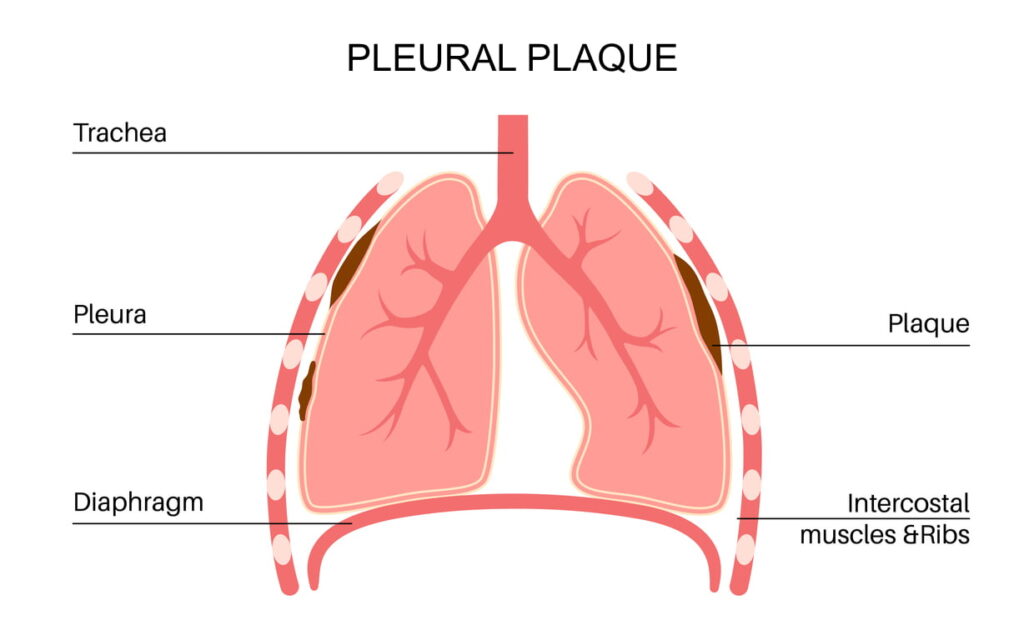Pleural plaques are harmless buildups of protein that grow in the pleura, the lining of the lungs. Pleural plaques can be caused by exposure to asbestos. If a U.S. veteran or civilian has pleural plaques, they could also be at risk of mesothelioma and other asbestos-related diseases. Learn about next steps to take if you or a loved one has pleural plaques.
What Is Pleural Plaque?
Pleural plaques are buildups of a protein known as collagen in the lung lining or chest wall. Pleural plaques are the most common asbestos-related disease, according to a 2020 American Journal of Respiratory and Critical Care Medicine report.

Pleural plaques on lungs aren’t cancerous and don’t cause any long-term health problems.
That said, U.S. veterans and civilians who have pleural plaques should stay alert for possible signs of serious asbestos-related diseases like mesothelioma. It’s possible to develop pleural plaques and mesothelioma since both conditions stem from asbestos exposure.
The Mesothelioma Veterans Center helps veterans with pleural plaques and other illnesses like mesothelioma or lung cancer access financial aid. Get started with a Free Asbestos Disease Case Review.
What Is the Cause of Pleural Plaques?
Asbestos exposure is the main cause of pleural plaques. When people work with asbestos-containing products, asbestos fibers can be released into the air.
Anyone in the area can then inhale or swallow the fibers, which get trapped in the lung lining and cause inflammation.
Asbestos fibers are so strong that the body can’t break them down. Instead, the body’s immune response will cause collagen to build up, creating pleural plaque in the lungs 10-50 years after asbestos exposure.
Pleural plaques can also develop after exposure to talc, ceramic fibers, or other minerals.
Who Is at the Greatest Risk of Pleural Plaque?


The military and many private industries used asbestos products prior to the early 1980s as asbestos was very durable and fireproof. Companies that made and sold asbestos-containing products knew their goods could cause life-threatening illnesses but hid the risks for decades.
While pleural plaques from asbestos aren’t dangerous, millions have died from other asbestos-related diseases. Contact us to get help if you or a loved one has an asbestos-caused health problem.
Pleural Plaques and Other Asbestos-Related Diseases
Those diagnosed with pleural lung plaques could be at risk of more serious asbestos-related diseases.
These diseases include:
- Lung cancer: Cancer tumors develop in lung tissue.
- Malignant pleural mesothelioma: In cases of this cancer, tumors develop in the pleura.
- Other asbestos pleural diseases: These include pleurisy (inflammation of the pleura), diffuse (widespread) pleural thickening, and pleural effusion (buildup of fluid between layers of the pleura).
A 2022 study from the American Journal of Industrial Medicine found that patients with pleural plaques were at a higher risk for developing mesothelioma.
However, the presence of pleural plaque doesn’t cause mesothelioma or other asbestos-related lung diseases. It’s the underlying asbestos exposure that puts patients at risk.
Symptoms of Pleural Plaques
Unlike other asbestos-related diseases, pleural plaques do not cause any symptoms.
However, if someone has asbestos plaques and is suffering from symptoms such as a cough, shortness of breath, or chest pain, they should see a doctor. These could be symptoms of more serious asbestos diseases like mesothelioma or lung cancer.
Diagnosing Pleural Plaques Caused by Asbestos
Since pleural plaques do not have any symptoms, patients are often diagnosed when undergoing imaging tests for unrelated health issues.
Pleural plaques can be found using:
- Chest X-rays (radiography)
- Computed tomography (CT) scans
- Magnetic resonance imaging (MRI) scans
Chest CTs are up to 100% accurate for diagnosing pleural plaques, so they are preferred by radiology professionals.
Plaques appear as white, nodular clumps or abnormalities in the lung lining on high-resolution scans. Pleural thickening may also be seen on diagnostic scans due to the buildup of plaque, according to Goldman's Cecil Medicine.
If you or a veteran you love have an asbestos-related disease, the Mesothelioma Veterans Center may be able to help. See how with a Free Asbestos Disease Case Review.
Types of Pleural Plaques
There are a few different types of pleural plaques that someone may be diagnosed with.
These types include:
- Bilateral pleural plaques: This is when doctors find pleural plaques on both sides of the chest. Bilateral pleural plaques are more likely to be caused by asbestos exposure than other toxins.
- Calcified pleural plaques: This type of plaque develops when pleural calcification builds up along with collagen. Calcified pleural plaques are easier to see on an X-ray but are much rarer, making up fewer than 15% of diagnoses.
- Hairy plaques: The pleura is made up of an outer lining and an inner lining. Most pleural plaques develop on or near the inner lining (parietal pleura). However, hairy plaques form near the outer lining (visceral pleura) and look like lines when seen on a CT scan.
What Is the Prognosis for Pleural Plaques?
Veterans and civilians with asbestos pleural plaques have a very good prognosis (projected health outlook). Patients with pleural plaques can live just as long as those without them.
While pleural plaque is a disease, it’s not one that causes harm or suffering. Remember, most U.S. veterans and civilians won’t even know they have them unless doctors happen to see the plaques on an imaging scan.
Likewise, the average survival rates and life expectancies for people with and without pleural plaques are the same.
How Do You Treat Pleural Plaque?
Doctors do not generally treat pleural plaques. This is because pleural plaques are noncancerous and do not affect lung function.
However, those who have asbestos-induced pleural plaques should see a doctor regularly. This is because they are at risk of much more dangerous asbestos-related diseases like mesothelioma later in life.
Doctors may be able to diagnose and treat more serious asbestos diseases before they spread thanks to regular followup screenings, allowing patients to live longer.
Both civilian doctors and mesothelioma specialists within the U.S. Department of Veterans Affairs (VA) health care system can recommend next steps for veterans who have pleural plaques.
Need help affording treatments for asbestos-related diseases? Our team can help you get financial aid if you qualify. Get a Free Asbestos Disease Case Review to start the process.
Help for Pleural Plaques and Other Asbestos Diseases
U.S. veterans risked their lives to defend their country — and many still pay with their lives each year due to asbestos-related diseases related to their service.
Pleural plaques aren’t deadly, but veterans and civilians with them are at risk of worse diseases like mesothelioma. Thankfully, if you have asbestos-related pleural plaques, you can take steps to stay on top of your health.
Here’s what our team recommends if you have pleural plaques:
- Get a free asbestos disease case review: Learn how to access financial aid for more serious asbestos-related illnesses like mesothelioma or lung cancer.
- See a doctor regularly for health screenings: Doing so can increase your chances of catching other asbestos diseases early on.
- Quit smoking: You have a high risk of lung cancer if you smoke and were exposed to asbestos. Your doctor can help you find programs to quit smoking.
The Mesothelioma Veterans Center helps veterans, civilians, and loved ones affected by asbestos-related diseases get financial aid and connect with resources. Call (877) 450-8973 to learn how we can help you.
Pleural Plaques FAQs
Can pleural plaques turn into cancer?
No, pleural plaques can’t turn into cancer. But, veterans and civilians who have pleural plaques run a higher risk of cancers like mesothelioma due to past exposure to asbestos.
What are the effects of pleural plaques?
There are no long-term or short-term health effects or symptoms of pleural plaques. They are simply buildups of a protein known as collagen (and sometimes calcium) within the lung lining.
Pleural plaques don’t require treatment, but they could mean you were exposed to asbestos. As a result, you should see a doctor if you start developing symptoms like a cough, shortness of breath, or chest pain.
Can pleural plaques cause COPD?
No, pleural plaques cannot cause chronic obstructive pulmonary disease (COPD).
That said, you or a loved one could develop COPD in the future if you currently have pleural plaques and were exposed to asbestos in the past. Both COPD and pleural plaques can be caused by asbestos exposure.
Can pleural plaques kill you?
No, pleural plaques can’t kill you. However, they can lead to increased risk of fatal conditions such as mesothelioma and lung cancer.
Civilian and VA health care professionals can recommend next steps if you have pleural plaques and are worried about more serious asbestos diseases. These steps may include getting regularly screened for cancer and quitting smoking.
Are pleural plaques the same as asbestosis?
No, pleural plaques are not the same as asbestosis. Asbestosis is also caused by inhaling or ingesting asbestos, but it is more severe than pleural plaques.
Pleural plaques usually cause no symptoms, while asbestosis is a progressive disease. It causes worsening chest pain and difficulty breathing, because lung function deteriorates over time due to the condition.

